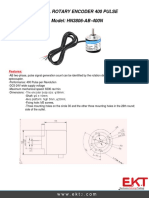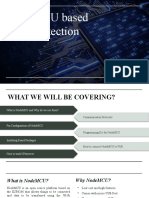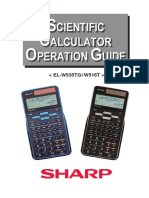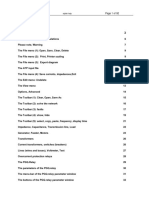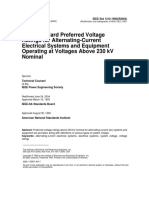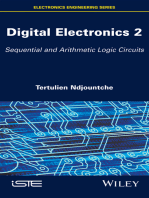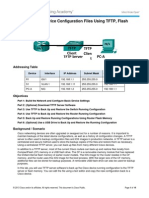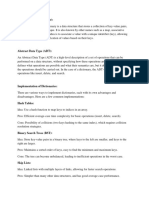Electric Machine Simulation
Uploaded by
herytriwElectric Machine Simulation
Uploaded by
herytriwElectric machines simulation with QuickField
Practical recommendations for practical engineers.
(corresponding QuickField examples are placed to ICEM 2011/motors folder in the root of your QuickField Demo CD)
Tera-Analysis Ltd
There are three main steps for the electric machine simulation in QuickField: 1. Geometry definition ! Defining the field sources (currents or permanent magnets) and material properties. " Results analysis.
1. Geometry definition
QuickField may sol#e plane-parallel or axysimmetrical tasks
$oughly speaking% rotating machine is formed &y t'o coaxial o&(ects ) rotor inside% and stator outside *f the axial length is not too small compared to the diameter% then the system may &e represented as a plane-parallel model
Real device
Simulation model
+sing this approach% !D analysis may often &e applied for the simulation of the acti#e ,one of electric machine ) i e the part 'hich generates the tor-ue% defines the current loads and flux densities .nd ,ones of electric machine usually re-uire "D simulation% and can not &e performed 'ith QuickField
. Field sources and material properties.
/ain modules of QuickField used for electric machine analysis are magnetostatics% AC magnetics and transient electromagnetics !agnetostatics may &e applied for the models 'ith non-linear magnetic materials% and permanent magnets 0ro#ides calculation of fluxes% tor-ues% forces "# !agnetics pro#ides field analysis for the models 'ith sinusoidal source currents of any fre-uency (up to /1, range)% 'ith eddy currents in solid conductors 2ut there should &e only one fre-uency for all #alues in the model% and therefore all the materials should &e considered as linear This formulation pro#ides the same outputs as /agnetostatics% plus possi&ilities for impedance calculation Transient $lectromagnetics expands all features and approaches of the /agnetostatics to the time domain 3upports linear and non-linear materials% formula-defined sources% and is most flexi&le for 'ide range of pro&lems 2ut transient analysis calculations are most time-consuming of all types of QuickField analysis% &ecause re-uire field calculation in many time steps 4ther QuickField modules may also &e useful for additional studies For example% Transient 1eat Transfer module may &e used for calculation of the temperature distri&ution% /echanical 3tresses may help to estimate the mechanical sta&ility% and DC Conduction ) for the calculation of the currents in the slot insulation
%. Results analysis
$esults% pro#ided &y QuickField% include local #alues% field maps% plots and integrals in any moment of time (in Transient pro&lems) or phase (in AC pro&lems)
How to model transformers with QuickField
"&ysimmetrical pro'lem5 Single phase transformer with concentric windings (lane)parallel pro'lem5 Most of other types of transformers (including 3 phase!" End #one effects should $e neglected% which may affect the accuracy
$&le. *ingle phase shell)core transformer.
6eometric model in QuickField 'ill look like this5
secondary winding primary winding
core
7indings are put concentrically one o#er another The thin 'ire filling the 'inding is represented &y the current layer $esults of the secondary 'inding electromoti#e force calculations look like5
To find the actual #alue of the secondary 'inding #oltage the displayed parameter should &e multiplied &y the num&er of the secondary 'inding turns This gi#es the secondary 'inding #oltage 'ith no load5 !88 8 !9" : 98 ; < 0lease% refer to the QuickField pro&lem in the =transformers> folder
How to model DC motors with QuickField
In &C motor the stator poles produce static magnetic field" 'he rotor field is also static $ecause the $rushes are fi(ed" 'wo static fields may $e simulated in &C Magnetics" $&le: #alculate the current)tor+ue caracteristic for the motor ,ith serial e&citation ,inding. 6eometric model looks like5
The la&els of the direct and re#erse currents of the core 'ere set according to the connection schema5
4 #
1"
11 $
12
13
14
15
16
17
1! #
2"
21
22
23
24
25
26 $
27
2!
3"
7inding in the rotor slots is defined &y the e-ui#alent single conductor This simplification does not affect to the magnetic field distri&ution All conductors 'ith the same direction of currents are assigned the same la&el La&el properties specify serial connection of the conductors
Resulting magnetic field& 'urrent$tor(ue caracteristic&
0lease% refer to the QuickField pro&lem in the =dc?motor> folder
How to model asynchronous motors with QuickField
'o simulate rotation the) slip fre*uency) approach should $e used
'he pro$lem with different rotation speeds of the rotor (w2! and magnetic field of the stator(w1! may $e replaced $y the pro$lem with stationary rotor and the stator field rotating with (w1 w2! speed" $&le: #alculation of the tor+ue)speed characteristic of the motor !(n) 4n the geometric model &elo' the &lock la&els% sho'ing the phases of the 'indings% are sho'n
3eries of the calculations 'ith the #aried stator current fre-uency gi#es the tor-ue-speed characteristic For this task com&ined use of QuickField 'ith La&el/o#er is recommended5 $esulting magnetic field5 Tor-ue-speed characteristic
0lease% refer to the QuickField pro&lem in the =ac?motor> folder
How to model different parts of electric machines in QuickField
1ints for the typical tasks of electric motor design are pro#ided &elo' *lot *n most cases there is no need to dra' all indi#idual conductors They may &e replaced &y single solid conductor% or% if there are se#eral layers of 'inding ) &y se#eral conductors (ole 0ole 'inding consists of many conductors This decreases eddy current effects% and it may &e supposed that the current density is uniformally distri&uted along the cross section of the 'inding 3uch 'inding may &e presented in QuickField &y a single &lock 'ith e#enly distri&uted current density -aminated cores There is no eddy currents in laminated cores .lectrical conducti#ity in the &lock properties should not &e defined @on-linear magnetic materials may &e defined in the DC magnetics or Transient electromagnetics *hort)circuited loops 3hort circuited loops may &e defined &y setting +:8 in the la&el properties *:8 means that the loop is disconnected *hort)circuited rotor 3hort-circuited rotor may &e presented in QuickField as a set of conductors% ha#ing the same la&el% and 'ith +:8 in this la&el properties Rotating magnetic field $otating magnetic field may &e simulated either in AC /agnetics or in Transient .lectromagnetics AC magnetics re-uires definition of the single fre-uency for all currents in the pro&lem% and setting of specific phases for e#ery current Transient .lectromagnetics allo'ing using formulas for currents definition% e g sin(tAB!8) $&ternal circuit AC magnetics and Transient electromagnetics in QuickField supports connection of the external circuit% and coupled simulation of the field and circuit parts of the pro&lem .eating of stator and rotor QuickField supports coupled pro&lems of AC magnetics (or Transient .lectromagnetics) 'ith 1eat Transfer Currents calculated in the conductors &y electromagnetic simulation may then &e used as heat sources in the thermal analysis !echanical deformations and stresses in the electric motor parts Coupled magneto-mechanical analysis may &e applied to calculate deformations and stresses in the parts of electric motors /agnetic forces% calculated &y electromagnetic simulation are then considered as a mechanical loads in the 3tress Analysis
Tera)"nalysis -td. /nasterho00e1 1 D/)2344 *0end'org Denmark
!ain office: (hone 562 77 4 7 41 Fa& 562 772% 8967 $)mail: support:+uickfield.com ;oth "merican office: Toll)free phone<fa& 51 (733) 12)7877 $)mail: ussupport:+uickfield.com
=ank: ;ordea =ank Danmark "<* Denmark *>?FT address: ;D$"D/// $@RA: account 8742442914318 ?=";: D/82 442442914318 @* B: account 87424429143 6 ?=";: D/6% 4424429143 6
-imited company registered in Denmark as "npartselska' ("p*) at the C"T num'er: D/ 2 41 6% 83
You might also like
- Roitt'S Essential Immunology 12Th Edition (All Mcqs With Answers)100% (9)Roitt'S Essential Immunology 12Th Edition (All Mcqs With Answers)100 pages
- Simulation of Some Power System, Control System and Power Electronics Case Studies Using Matlab and PowerWorld SimulatorFrom EverandSimulation of Some Power System, Control System and Power Electronics Case Studies Using Matlab and PowerWorld SimulatorNo ratings yet
- Optimization of Large Industrial Magnets With Source Codes, Edition-2, 2022100% (1)Optimization of Large Industrial Magnets With Source Codes, Edition-2, 202244 pages
- GE Transient Voltage Suppression Manual 1976No ratings yetGE Transient Voltage Suppression Manual 1976116 pages
- Get Digital Electronics: Principles and Applications 9th Edition Roger L. Tokheim - Ebook PDF Free All Chapters100% (5)Get Digital Electronics: Principles and Applications 9th Edition Roger L. Tokheim - Ebook PDF Free All Chapters49 pages
- Electric Drives: An Electric Drive Is A System That Converts Electrical Energy To Mechanical Energy91% (11)Electric Drives: An Electric Drive Is A System That Converts Electrical Energy To Mechanical Energy33 pages
- Lession-35 - 3-Phase Voltage Source Inverter With Square Wave OutputNo ratings yetLession-35 - 3-Phase Voltage Source Inverter With Square Wave Output11 pages
- MOSFET Selection To Minimize Losses in Low Output Voltage DC DC ConvertersNo ratings yetMOSFET Selection To Minimize Losses in Low Output Voltage DC DC Converters23 pages
- An Integrated Inverter Output Passive Sinewave Filter For Eliminating Both Common and Differential Mode PWM Motor Drive ProblemsNo ratings yetAn Integrated Inverter Output Passive Sinewave Filter For Eliminating Both Common and Differential Mode PWM Motor Drive Problems7 pages
- Jump, Loop and Call Instructions: University of Engineering and Technology TaxilaNo ratings yetJump, Loop and Call Instructions: University of Engineering and Technology Taxila93 pages
- A Guide For Using PTM and The CPC 100 To Test TransformersNo ratings yetA Guide For Using PTM and The CPC 100 To Test Transformers56 pages
- Study of Double Cage Induction Motors With Different Rotor Bar MaterialsNo ratings yetStudy of Double Cage Induction Motors With Different Rotor Bar Materials7 pages
- A Comparative Study of Field-Oriented Control and Direct-Torque Control of Induction Motors Using An Adaptive Flux ObserverNo ratings yetA Comparative Study of Field-Oriented Control and Direct-Torque Control of Induction Motors Using An Adaptive Flux Observer15 pages
- Common Format For Exchange of Solved Load Flow Data PDFNo ratings yetCommon Format For Exchange of Solved Load Flow Data PDF10 pages
- Powerformers: A Breakthrough of High-Voltage Power Generators100% (5)Powerformers: A Breakthrough of High-Voltage Power Generators8 pages
- Electric Drives Concepts and Applications by Vedam Subrahmanyam 0074603701 PDFNo ratings yetElectric Drives Concepts and Applications by Vedam Subrahmanyam 0074603701 PDF5 pages
- IEEE - 1312 - 2004 Preferred Voltage Ratings Above 230 KVNo ratings yetIEEE - 1312 - 2004 Preferred Voltage Ratings Above 230 KV6 pages
- Experiment 12 Transmission Line Parameters - Series Impedence and Shunt Capacitance Calculations Using MATLABNo ratings yetExperiment 12 Transmission Line Parameters - Series Impedence and Shunt Capacitance Calculations Using MATLAB6 pages
- Ferrites For Inductors and TransformersNo ratings yetFerrites For Inductors and Transformers185 pages
- Digital Electronics 2: Sequential and Arithmetic Logic CircuitsFrom EverandDigital Electronics 2: Sequential and Arithmetic Logic Circuits5/5 (1)
- Visualization and Animation of Transformer, Electrical Machines and Electrical Drives Working PrinciplesNo ratings yetVisualization and Animation of Transformer, Electrical Machines and Electrical Drives Working Principles4 pages
- Ansys Electric Machines and Power ElectronicsNo ratings yetAnsys Electric Machines and Power Electronics58 pages
- Ansys Electric Machines and Power ElectronicsNo ratings yetAnsys Electric Machines and Power Electronics58 pages
- 11.4.2.7 Lab - Managing Device Configuration FilesNo ratings yet11.4.2.7 Lab - Managing Device Configuration Files14 pages
- Y5 Autumn Block 5 Wo3 Area of Rectangles 2019No ratings yetY5 Autumn Block 5 Wo3 Area of Rectangles 20192 pages
- Honeywell Analytics Calibration Handbook 2016No ratings yetHoneywell Analytics Calibration Handbook 2016164 pages
- Eec 324 Practice Questions With AnswersNo ratings yetEec 324 Practice Questions With Answers11 pages
- Typical Joint Detailing of Steel Hollow SectionsNo ratings yetTypical Joint Detailing of Steel Hollow Sections7 pages
- Download Basic Engineering Physics WBUT 2013 3rd Edition Sujay Kumar Bhattacharya ebook All Chapters PDF100% (10)Download Basic Engineering Physics WBUT 2013 3rd Edition Sujay Kumar Bhattacharya ebook All Chapters PDF82 pages
- DIGITAL LOGIC DESIGN MIDTERM EXAM JANUARY 2025No ratings yetDIGITAL LOGIC DESIGN MIDTERM EXAM JANUARY 20254 pages
- Advantages and Disadvantages of air coolerNo ratings yetAdvantages and Disadvantages of air cooler152 pages
- Class 11 Physics Notes Chapter 10 Thermal Properties of MatterNo ratings yetClass 11 Physics Notes Chapter 10 Thermal Properties of Matter62 pages
- Roitt'S Essential Immunology 12Th Edition (All Mcqs With Answers)Roitt'S Essential Immunology 12Th Edition (All Mcqs With Answers)
- Simulation of Some Power System, Control System and Power Electronics Case Studies Using Matlab and PowerWorld SimulatorFrom EverandSimulation of Some Power System, Control System and Power Electronics Case Studies Using Matlab and PowerWorld Simulator
- Optimization of Large Industrial Magnets With Source Codes, Edition-2, 2022Optimization of Large Industrial Magnets With Source Codes, Edition-2, 2022
- Get Digital Electronics: Principles and Applications 9th Edition Roger L. Tokheim - Ebook PDF Free All ChaptersGet Digital Electronics: Principles and Applications 9th Edition Roger L. Tokheim - Ebook PDF Free All Chapters
- Electric Drives: An Electric Drive Is A System That Converts Electrical Energy To Mechanical EnergyElectric Drives: An Electric Drive Is A System That Converts Electrical Energy To Mechanical Energy
- Lession-35 - 3-Phase Voltage Source Inverter With Square Wave OutputLession-35 - 3-Phase Voltage Source Inverter With Square Wave Output
- MOSFET Selection To Minimize Losses in Low Output Voltage DC DC ConvertersMOSFET Selection To Minimize Losses in Low Output Voltage DC DC Converters
- An Integrated Inverter Output Passive Sinewave Filter For Eliminating Both Common and Differential Mode PWM Motor Drive ProblemsAn Integrated Inverter Output Passive Sinewave Filter For Eliminating Both Common and Differential Mode PWM Motor Drive Problems
- Jump, Loop and Call Instructions: University of Engineering and Technology TaxilaJump, Loop and Call Instructions: University of Engineering and Technology Taxila
- A Guide For Using PTM and The CPC 100 To Test TransformersA Guide For Using PTM and The CPC 100 To Test Transformers
- Study of Double Cage Induction Motors With Different Rotor Bar MaterialsStudy of Double Cage Induction Motors With Different Rotor Bar Materials
- A Comparative Study of Field-Oriented Control and Direct-Torque Control of Induction Motors Using An Adaptive Flux ObserverA Comparative Study of Field-Oriented Control and Direct-Torque Control of Induction Motors Using An Adaptive Flux Observer
- Common Format For Exchange of Solved Load Flow Data PDFCommon Format For Exchange of Solved Load Flow Data PDF
- Powerformers: A Breakthrough of High-Voltage Power GeneratorsPowerformers: A Breakthrough of High-Voltage Power Generators
- Electric Drives Concepts and Applications by Vedam Subrahmanyam 0074603701 PDFElectric Drives Concepts and Applications by Vedam Subrahmanyam 0074603701 PDF
- IEEE - 1312 - 2004 Preferred Voltage Ratings Above 230 KVIEEE - 1312 - 2004 Preferred Voltage Ratings Above 230 KV
- Experiment 12 Transmission Line Parameters - Series Impedence and Shunt Capacitance Calculations Using MATLABExperiment 12 Transmission Line Parameters - Series Impedence and Shunt Capacitance Calculations Using MATLAB
- Computer Aided Design of Electrical MachinesFrom EverandComputer Aided Design of Electrical Machines
- Digital Electronics 3: Finite-state MachinesFrom EverandDigital Electronics 3: Finite-state Machines
- Digital Electronics 2: Sequential and Arithmetic Logic CircuitsFrom EverandDigital Electronics 2: Sequential and Arithmetic Logic Circuits
- Worked Examples in Mechanics of Machines using MATLABFrom EverandWorked Examples in Mechanics of Machines using MATLAB
- Visualization and Animation of Transformer, Electrical Machines and Electrical Drives Working PrinciplesVisualization and Animation of Transformer, Electrical Machines and Electrical Drives Working Principles
- 11.4.2.7 Lab - Managing Device Configuration Files11.4.2.7 Lab - Managing Device Configuration Files
- Download Basic Engineering Physics WBUT 2013 3rd Edition Sujay Kumar Bhattacharya ebook All Chapters PDFDownload Basic Engineering Physics WBUT 2013 3rd Edition Sujay Kumar Bhattacharya ebook All Chapters PDF
- Class 11 Physics Notes Chapter 10 Thermal Properties of MatterClass 11 Physics Notes Chapter 10 Thermal Properties of Matter






















